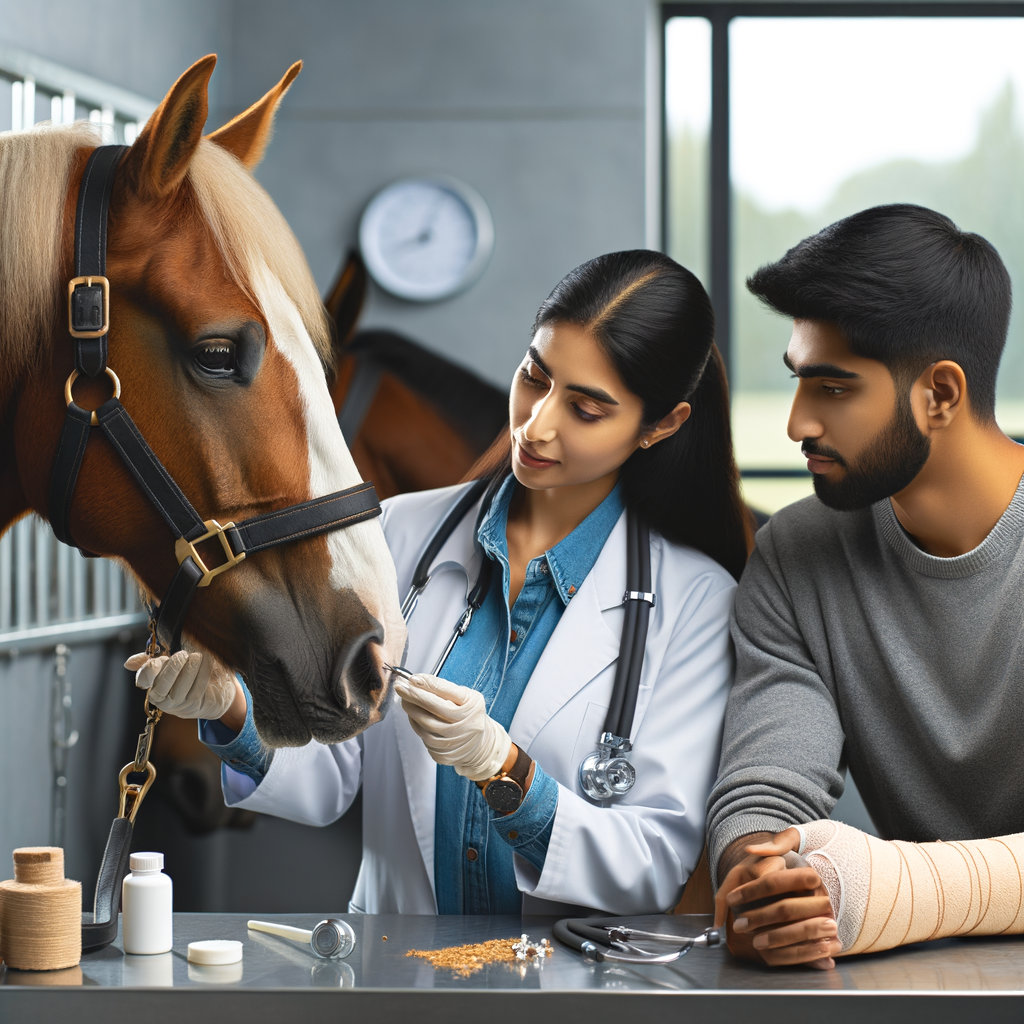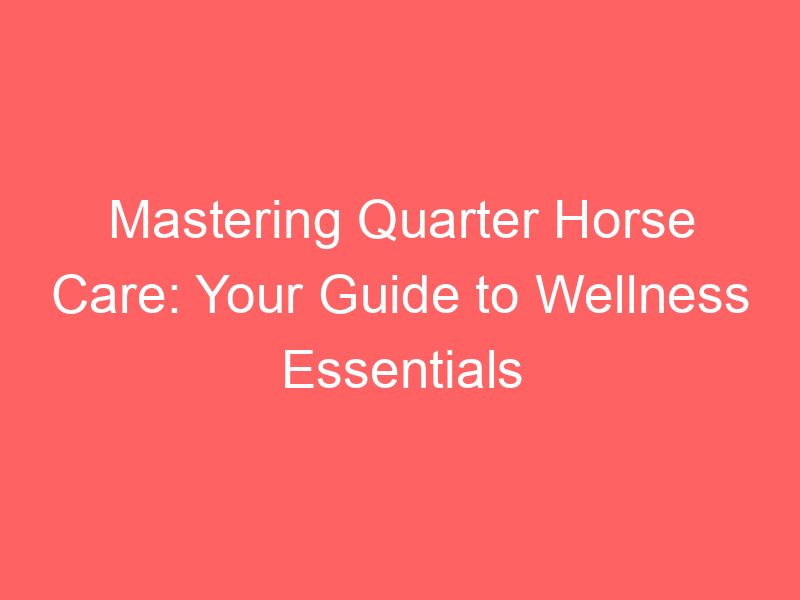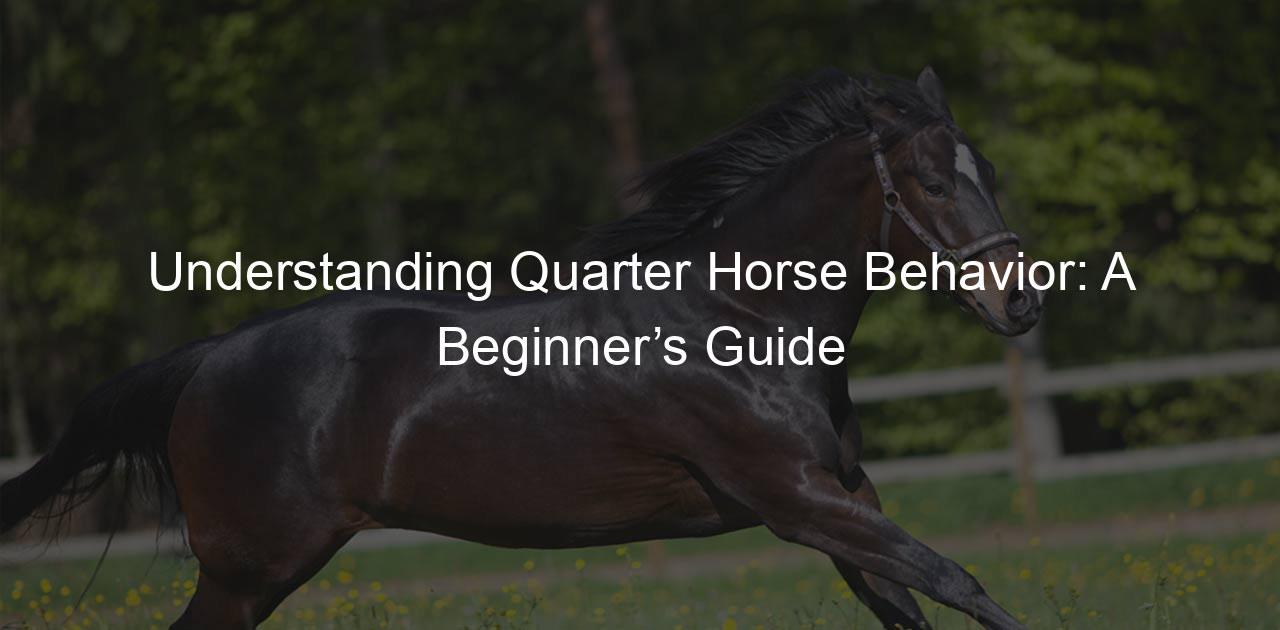
Introduction to Comprehensive Horse Care
When it comes to owning and caring for a horse, there’s a lot to consider. From their diet to their exercise routine, each aspect of horse care plays a crucial role in their overall health and happiness. This guide will provide a comprehensive look at the essentials of horse care, focusing on the unique needs of the Quarter Horse breed.
- Understanding the Importance of Quarter Horse Care
- Introduction to Wellness Essentials for Horses
- Regular Exercise: Horses need daily exercise to maintain their health and prevent obesity. This can include riding, lunging, or free play in a safe, enclosed area.
- Proper Nutrition: A balanced diet is crucial for a horse’s health. This typically includes hay or pasture, grains, and plenty of fresh water. Supplements may also be necessary depending on the horse’s age, activity level, and health status.
- Regular Vet Check-ups: Regular vet visits can help catch any potential health issues early. Your vet can also provide advice on diet, exercise, and other aspects of horse care.
- Proper Grooming: Regular grooming not only keeps your horse looking its best, but it also provides an opportunity to check for any skin issues or injuries.
Quarter Horses are a popular breed known for their versatility and friendly nature. However, they also have specific care needs that differ from other breeds. Understanding these needs is crucial to ensure your Quarter Horse remains healthy and happy.
For instance, Quarter Horses are prone to certain health issues like obesity and laminitis due to their muscular build and active lifestyle. Regular vet check-ups, a balanced diet, and proper exercise can help prevent these issues and ensure your horse is in top shape.
Regardless of breed, there are some universal wellness essentials that every horse owner should be aware of. These include:
By understanding and implementing these wellness essentials, you can ensure your horse leads a long, healthy, and happy life.
Understanding Quarter Horse Health
When it comes to the health of Quarter Horses, it’s essential to understand that their physical health plays a crucial role. Let’s delve into the key aspects of their physical health, including the importance of regular exercise and understanding their diet.
Physical Health
- Importance of Regular Exercise
- Understanding the Quarter Horse’s Diet
Regular exercise is vital for a Quarter Horse’s health. It helps maintain a healthy weight, strengthens their muscles, and improves their cardiovascular system. Exercise also plays a significant role in their mental well-being, reducing stress and anxiety. A study found that horses that engage in regular exercise are less likely to develop health issues such as obesity and heart disease.
Exercise routines for Quarter Horses can vary based on their age, health condition, and the purpose they serve (racing, workhorse, etc.). However, a good rule of thumb is to ensure they get at least an hour of moderate exercise every day. This could include activities like trotting, cantering, or even a brisk walk.
The diet of a Quarter Horse is another crucial aspect of their physical health. These horses are known for their robust physique and high energy levels, which they derive from a well-balanced diet. The primary components of their diet should include hay, grains, and plenty of fresh water.
Hay is the main source of fiber and should make up about 50-60% of their diet. Grains like oats, corn, and barley provide the necessary carbohydrates and proteins. It’s also important to include a variety of fruits and vegetables for added vitamins and minerals. Remember, the diet should be adjusted based on the horse’s age, weight, and activity level.
In conclusion, taking care of a Quarter Horse’s physical health involves regular exercise and a balanced diet. By ensuring these two aspects, you can help your horse lead a healthier and happier life.
Mental Health
Just like humans, horses too need mental stimulation and a healthy environment to thrive. This is especially true for Quarter Horses, a breed known for their intelligence and agility. In this section, we will delve into the importance of mental stimulation and how to create a conducive environment for your Quarter Horse.
- Understanding the Importance of Mental Stimulation
- How to Provide a Healthy Environment for Your Quarter Horse
Mental stimulation is as crucial for horses as physical exercise. It helps in keeping them engaged, happy, and prevents the onset of behavioral issues. For instance, a study conducted by the University of Bristol found that horses that lack mental stimulation often develop habits like cribbing and weaving.
Providing mental stimulation for your Quarter Horse can be as simple as introducing new toys in their environment, varying their training routines, or allowing them to socialize with other horses. Remember, a mentally stimulated horse is a happy and healthy horse.
A healthy environment is fundamental to your Quarter Horse’s mental well-being. This involves more than just clean stables and regular meals. A healthy environment for a Quarter Horse includes ample space to roam, opportunities for social interaction, and a varied diet.
Ensure your horse has access to a pasture where they can graze and play. Interaction with other horses is also crucial as it allows them to express their natural herd behaviors. Lastly, a varied diet mimics the horse’s natural feeding behaviors, keeping them mentally engaged and satisfied.
| Mental Health Tips for Your Quarter Horse |
|---|
| Provide a variety of toys and training routines for mental stimulation |
| Ensure access to a pasture for free movement and grazing |
| Allow social interaction with other horses |
| Provide a varied diet to mimic natural feeding behaviors |
In conclusion, mental health is a vital aspect of your Quarter Horse’s overall well-being. By providing mental stimulation and a healthy environment, you can ensure that your horse remains happy, healthy, and ready to give their best, whether in a competition or a leisurely trail ride.
Equine Wellness: A Comprehensive Guide
When it comes to horse care, prevention is always better than cure. In this section, we will delve into the critical aspects of preventive care for horses, focusing on regular vet check-ups and the importance of vaccinations.
Preventive Care
Preventive care is the cornerstone of equine wellness. It involves taking proactive measures to ensure your horse stays healthy and reduces the risk of diseases. Two key components of preventive care are regular vet check-ups and vaccinations.
- Regular Vet Check-ups
- Importance of Vaccinations
Regular veterinary check-ups are essential for maintaining your horse’s health. These check-ups allow for early detection of potential health issues, which can be treated before they become serious problems. A typical check-up includes a physical examination, dental check, and hoof care. Your vet may also recommend blood tests or other diagnostic procedures based on your horse’s age, breed, and lifestyle.
Vaccinations play a crucial role in protecting your horse from various infectious diseases. They work by stimulating the horse’s immune system to recognize and fight off specific viruses or bacteria. Some of the common diseases that horses are vaccinated against include Equine Influenza, Tetanus, and West Nile Virus. Your vet can provide a vaccination schedule tailored to your horse’s specific needs.
In conclusion, preventive care, including regular vet check-ups and vaccinations, is a vital part of equine wellness. By investing time and effort in these areas, you can help ensure your horse leads a long, healthy, and happy life.
Emergency Care
When it comes to the health of your Quarter Horse, knowing how to respond in an emergency is crucial. Let’s explore how to recognize signs of distress and what to do in an emergency situation.
- Recognizing Signs of Distress
- Changes in eating or drinking habits
- Unusual lethargy or restlessness
- Difficulty standing or walking
- Excessive sweating or panting
- What to Do in an Emergency
- Stay Calm: Your horse can sense your emotions. Staying calm can help prevent further distress.
- Contact a Vet: Always contact a vet as soon as possible. They can provide guidance and help you assess the situation.
- Keep Your Horse Comfortable: If possible, move your horse to a quiet, safe place. Avoid moving your horse if it appears injured.
Understanding your horse’s normal behavior is key to recognizing signs of distress. If your horse is acting unusually, it may be a sign of distress. Some common signs include:
Remember, these are just a few examples. If you notice any unusual behavior, it’s always best to consult with a vet.
In an emergency, your actions can greatly affect your horse’s wellbeing. Here are some steps to follow:
Remember, every situation is different. Always follow the advice of your vet.
In conclusion, recognizing signs of distress and knowing what to do in an emergency are vital parts of horse care. By staying informed and prepared, you can help ensure your Quarter Horse’s health and wellbeing.
Horse Healthcare Essentials: Caring for Quarter Horses
When it comes to caring for Quarter Horses, two of the most crucial aspects are grooming and hygiene. A well-groomed horse not only looks great but also feels good and performs better. Let’s delve into the essentials of grooming and dental care for your Quarter Horse.
Grooming and Hygiene
Proper grooming and hygiene practices are vital for maintaining the health and well-being of your Quarter Horse. These practices not only enhance the horse’s physical appearance but also contribute to its overall health. Let’s explore the two key aspects of grooming and hygiene.
- Regular grooming routines
- Importance of dental care
Regular grooming is an essential part of horse care. It helps keep the horse’s coat clean and shiny, prevents skin diseases, and strengthens the bond between the horse and its owner. A typical grooming routine should include brushing the horse’s body, mane, and tail, cleaning its hooves, and checking for any signs of injury or illness. It’s recommended to groom your Quarter Horse at least once a day.
Dental care is often overlooked in horse care, but it’s as important as any other aspect. Horses’ teeth continue to grow throughout their lives, and without proper dental care, they can develop sharp edges that can cause discomfort and affect their ability to eat. Regular dental check-ups by a qualified equine dentist can help prevent dental problems and ensure your horse’s overall health. It’s recommended to have your Quarter Horse’s teeth checked at least once a year.
In conclusion, regular grooming and dental care are vital for maintaining the health and well-being of your Quarter Horse. By incorporating these practices into your horse care routine, you can ensure your horse looks great, feels good, and performs at its best.
Nutrition
When it comes to caring for Quarter Horses, understanding their nutritional needs and choosing the right feed is crucial. Let’s delve into these topics.
-
Understanding the Quarter Horse’s nutritional needs
Quarter Horses, known for their agility and speed, have unique nutritional needs. They require a balanced diet to maintain their health and performance. This includes a mix of proteins, carbohydrates, fats, vitamins, and minerals.
Proteins are essential for muscle development and repair. Carbohydrates and fats provide the energy needed for their active lifestyle. Vitamins and minerals are vital for various bodily functions, including immune system support and bone health.
It’s important to note that the nutritional needs of a Quarter Horse can vary based on factors such as age, activity level, and health status. For instance, a young, active Quarter Horse may require more protein and energy compared to an older, less active one.
Nutrient Function Proteins Muscle development and repair Carbohydrates and fats Energy provision Vitamins and minerals Support various bodily functions -
Choosing the right feed
Selecting the right feed for your Quarter Horse is a crucial part of meeting their nutritional needs. The feed should be high-quality and balanced, providing all the necessary nutrients in the right proportions.
Hay is a staple in a Quarter Horse’s diet, providing necessary fiber. Grain-based feeds can supplement energy needs, while specialized feeds can address specific nutritional needs, such as extra protein for muscle development or added vitamins and minerals for overall health.
Remember, it’s not just about what you feed your Quarter Horse, but also how much and when. Overfeeding can lead to obesity and other health issues, while underfeeding can result in malnutrition. Regular feeding schedules help maintain a healthy digestive system.
Consulting with a veterinarian or an equine nutritionist can provide valuable guidance in choosing the right feed for your Quarter Horse.
Quarter Horse Wellness Tips: Essential Horse Care
When it comes to maintaining the health and wellness of your Quarter Horse, a balanced approach to exercise and training is crucial. This section will provide you with essential tips on creating a balanced exercise routine and training your Quarter Horse effectively.
Exercise and Training
Exercise and training play a pivotal role in the overall health and wellness of your Quarter Horse. Not only does it keep your horse physically fit, but it also stimulates their mental health and helps to prevent behavioral problems. Let’s delve into the details.
- Creating a Balanced Exercise Routine
Creating a balanced exercise routine for your Quarter Horse is not as daunting as it may seem. The key is to incorporate a variety of activities that will engage different muscle groups and keep your horse interested. For instance, you can alternate between light activities such as walking and grazing, and more intense exercises like trotting and galloping. Remember, consistency is key. Aim for at least 30 minutes of exercise per day.
- Training Tips for Quarter Horses
Training your Quarter Horse requires patience, consistency, and understanding. Here are some tips to help you:
- Start with basic commands: Before moving on to complex tasks, ensure your horse has mastered basic commands such as stop, go, and turn.
- Use positive reinforcement: Rewarding your horse when they follow a command correctly can encourage them to repeat the behavior.
- Be consistent: Horses learn through repetition. Be consistent with your commands and training sessions.
- Stay patient: Training takes time. Don’t rush the process. Remember, the goal is to build a strong, trusting relationship with your horse.
By following these tips, you can ensure your Quarter Horse stays healthy, happy, and well-trained.
Rest and Recovery
Just like humans, horses need rest and recovery after exercise. This part of horse care is often overlooked, but it is just as important as the exercise itself. Let’s delve into the importance of rest periods and how to facilitate recovery after exercise.
- Understanding the Importance of Rest Periods
- How to Facilitate Recovery After Exercise
Rest periods are essential for the overall health and well-being of your Quarter Horse. It is during these periods that the horse’s body repairs itself and builds strength. Rest also helps prevent injuries and illnesses, which can be costly and time-consuming to treat.
According to a study by the American Veterinary Medical Association, horses that do not get adequate rest are more likely to suffer from health issues like laminitis and colic. So, it’s crucial to ensure your horse gets enough downtime.
Facilitating recovery after exercise involves several steps. First, it’s important to cool down your horse properly. This can be done by walking your horse around for about 15 minutes after a workout. This helps to gradually lower the horse’s heart rate and prevent muscle stiffness.
Next, make sure your horse is well-hydrated. Horses can lose a significant amount of water through sweat during exercise, so it’s important to replace this by providing fresh, clean water.
Finally, provide your horse with a balanced diet. Good nutrition is key to recovery as it provides the necessary nutrients for muscle repair and growth.
In conclusion, rest and recovery are vital components of horse care. By understanding the importance of rest periods and knowing how to facilitate recovery, you can ensure your Quarter Horse stays healthy and strong.
Health and Wellness for Quarter Horses: Case Studies
Understanding the health and wellness of Quarter Horses is not just about theory. It’s also about real-life examples. Let’s dive into some case studies that highlight the importance of proper horse care.
Case Study 1: Successful Rehabilitation
Meet Star, a Quarter Horse who faced a challenging journey to recovery. Star was found in a neglected state, with severe malnutrition and hoof problems. However, with the right care, she was successfully rehabilitated. Here’s how it happened.
| Initial Condition | Rehabilitation Process | Final Outcome |
|---|---|---|
| Star was malnourished and had hoof problems. | Star was given a balanced diet and regular hoof care. | Star gained weight and her hooves improved significantly. |
Star’s initial condition was dire. She was severely underweight, and her hooves were in a terrible state. But the rehabilitation team didn’t lose hope. They started with a balanced diet to help Star gain weight. They also provided regular hoof care, which is crucial for any horse’s health.
Over time, Star began to show signs of improvement. She started gaining weight, and her hooves started to heal. It was a slow process, but the team was patient and persistent. They knew that rehabilitation takes time and consistency.
Finally, after months of hard work and dedication, Star was fully rehabilitated. She was healthy, her hooves were in excellent condition, and she was ready to live a normal horse life. Star’s case is a testament to the power of proper horse care and the importance of patience and persistence.
Remember, every horse is unique, and what worked for Star might not work for another horse. But the key takeaway is this: with the right care and dedication, it’s possible to rehabilitate a horse and give it a new lease on life.
Stay tuned for more case studies that delve into the health and wellness of Quarter Horses.
Case Study 2: Overcoming Behavioral Issues
Behavioral issues in Quarter Horses can often be a challenge. However, with the right approach, it is possible to overcome these issues. Let’s explore a case study that demonstrates this.
Background
Meet Star, a 7-year-old Quarter Horse mare, known for her exceptional speed and agility. However, Star began to exhibit unusual behavior. She became aggressive, refused to follow commands, and showed signs of fear and anxiety.
Identifying the Problem
The owner noticed these changes and sought help from a professional equine behaviorist. After a thorough evaluation, it was determined that Star was suffering from a behavioral disorder triggered by past trauma.
The Approach
The behaviorist recommended a comprehensive approach to address Star’s issues. This included a combination of behavioral training, changes in her environment, and therapeutic interventions.
| Intervention | Outcome |
|---|---|
| Behavioral Training | Star began to respond positively to commands, showing a decrease in aggressive behavior. |
| Environmental Changes | Adjustments to her living space reduced her anxiety levels. |
| Therapeutic Interventions | Therapies like massage and aromatherapy helped Star relax and become more comfortable. |
Results
After several months of consistent efforts, there was a significant improvement in Star’s behavior. She became more cooperative, less anxious, and her aggressive behavior reduced considerably. This case study shows that with the right approach and patience, behavioral issues in Quarter Horses can be effectively managed.
Key Takeaways
- Identifying behavioral issues early can help in addressing them effectively.
- Professional help can provide the right approach to manage these issues.
- Patience and consistency are key in dealing with behavioral problems in horses.
Case Study 3: Managing Chronic Health Conditions
When it comes to horse care, managing chronic health conditions is a significant challenge. This case study focuses on a Quarter Horse named Daisy, who was diagnosed with a chronic respiratory condition. Let’s delve into how Daisy’s health was managed effectively.
Identifying the Problem
At first, Daisy’s owners noticed she was breathing heavily even after light exercise. They contacted a veterinarian who diagnosed Daisy with a chronic respiratory condition. This condition is common in horses and can be managed with proper care and treatment.
Implementing the Treatment Plan
With the help of the vet, Daisy’s owners implemented a comprehensive treatment plan. This included medication, regular exercise, and a special diet. They also made sure Daisy’s living environment was clean and dust-free to prevent exacerbating her condition.
| Treatment | Details |
|---|---|
| Medication | Prescribed by the vet to manage symptoms |
| Exercise | Light, regular exercise to strengthen her lungs |
| Diet | Special diet rich in nutrients to boost her immune system |
| Environment | Clean, dust-free stable to prevent respiratory flare-ups |
Results of the Treatment Plan
After several months of this treatment plan, Daisy’s condition improved significantly. She was able to exercise without heavy breathing and her overall health improved. This case study shows how effective management of chronic conditions can lead to a healthier, happier horse.
Managing chronic health conditions in horses requires dedication and a comprehensive care plan. But with the right approach, it’s possible to manage these conditions and ensure your horse leads a healthy, active life.
Key Takeaways
- Chronic health conditions in horses can be managed effectively with the right care and treatment.
- Regular vet check-ups, medication, exercise, a proper diet, and a clean environment are crucial in managing chronic conditions.
- With proper care, horses with chronic conditions can lead healthy, active lives.
Remember, every horse is unique and what worked for Daisy might not work for all. Always consult with a professional veterinarian for a treatment plan tailored to your horse’s specific needs.
Conclusion: Mastering Quarter Horse Care
After delving into the comprehensive world of Quarter Horse care, we have reached the end of our guide. We have explored various aspects of horse health, wellness essentials, and practical tips to ensure your horse’s wellbeing. Let’s recap the key takeaways and share some final thoughts on wellness essentials for horses.
- Key takeaways from the guide
- Final thoughts on Wellness Essentials for Horses
Understanding and maintaining your Quarter Horse’s health is a multifaceted task. It involves regular health check-ups, a balanced diet, proper exercise, and mental stimulation. We learned that each horse is unique and requires a personalized care plan. The case studies highlighted the importance of preventive care and early detection of health issues.
The wellness of your Quarter Horse is not just about physical health. It’s about creating an environment where your horse can thrive, both physically and mentally. Regular grooming, social interaction, and a safe, comfortable living environment are just as important as medical care and nutrition. Remember, a happy horse is a healthy horse.
In conclusion, mastering Quarter Horse care is a rewarding journey. It requires dedication, knowledge, and a deep understanding of your horse’s needs. But the bond you build with your horse and the joy of seeing them healthy and happy makes it all worthwhile.
“There is something about the outside of a horse that is good for the inside of a man.” – Winston Churchill
May this guide serve as a stepping stone in your journey towards mastering Quarter Horse care. Happy riding!









